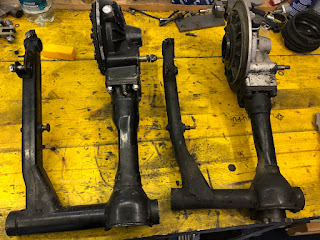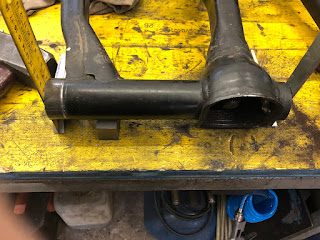... because to be quite honest, I somewhat failed in the "looks"-department. The setup is fairly straight-forward: a power-supply, zinc-plate/-anodes, some white vinegar and salt and some blue-chroming solution.
But I'll be honest straight away, I didn't make my own zinc-solution as I couldn't get my hands on sufficiently undiluted white vinegar. (40 percent essence would have been the ticket.)
The process is fairly simple. All the parts have to be clean and I don't mean clean, but eat your dinner of them clean. All traces of grease, oil, etc. have to be removed, which I did by dipping them in acetone for a good few minutes. (As the final parts show no fingerprints etc. that seems to have worked rather well.)
Next step is the actual Zinc-plating and it's equally straight forward: workpiece on negative (-) and your zinc-anode/roofing-sheet/drain-pipe on positive (+). The trick and that's where I suspect my somewhat sub-par results came from is to do it sufficiently slowly. 9V and around 5A is cool and gets a lot of Zinc into the solution, but you end up with rather furry workpieces. I suspect 6V and 1A (or maybe even less) is the ticket to a nice surface finish. Either way, if you see bubbles on your workpiece things are going the right way. On 5A 2 minutes were more or less sufficient to uniformly coat it black/dark grey.
Watching the Zinc "creep" over the workpiece is very cool to watch.
After about a minute the distribution is still rather uneven.
The part where you can't cheat as easily and shouldn't make the solution yourself, because of potentially cancerous Chromium-compounds in gaseous form, is the blue-chroming solution. It's very straight forward to be honest. Just dip the part and watch the results.
For a full blown silver(-ish) Chrome layer to be deposited the parts have to reside in the solution for about two minutes.
Obviously in the cold it needs a bit more than that. I'll add the results to this post, once I've had the parts in a bit longer. Technically it's probably alright with the Zinc-layer on the thick side, but as at least some of the mounts will be rather well visible on the sidecar, a bit of vanity shall be allowed this time.






































